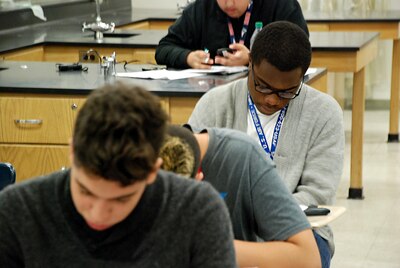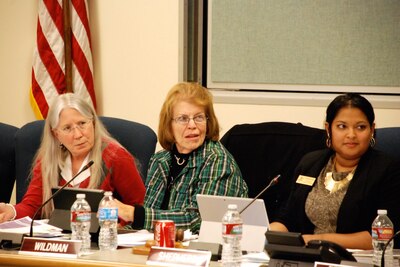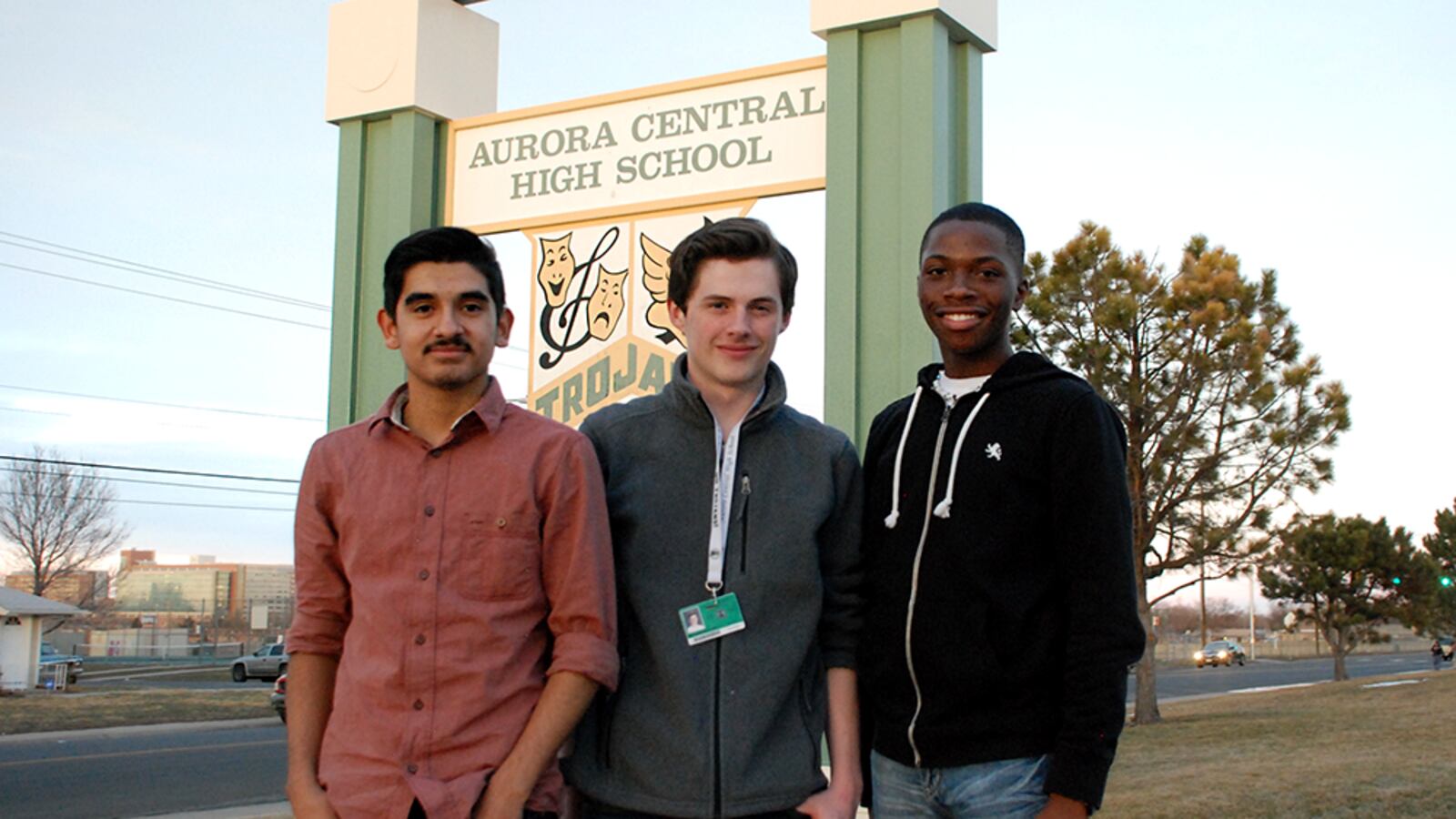AURORA — If you had asked Aurora Central High School students Juan Carbajal, Matthew Bouchey and Savion Harris six months ago if they would play an integral part in saving one of Colorado’s most troubled high schools, they would have laughed.
“I never thought the school would change,” said Bouchey, a sophomore. “I thought I’d go through all four years doing the same thing, just with different classes and different teachers.”
But today, the three students can speak about the intricacies of school design and education policies like the most entrenched edu-wonk. That’s because the trio has helped a team of teachers, parents and administrators reconceive what Aurora Central could look like next year.
Their school is one of about 150 Colorado schools at risk of state sanctions if student test results and graduation rates don’t increase in the coming years. The Aurora school district is also at risk of losing its accreditation with the state.
As a last-ditch effort, five schools in the Original Aurora neighborhood are being redesigned under a 2008 state law that gives schools certain freedoms to chart their own paths.
The first drafts of those plans were released last week.
Chalkbeat spoke with the Aurora Central students about their new principal, their role on the design team and what they hope to see change. They also shared their startling discovery that Aurora Central is not alone in its improvement efforts. The students said they had no idea that work being done at Aurora Central was similar to efforts playing out at schools across the country.
This interview has been edited for brevity and clarity.
What’s this school year been like?
Juan: I definitely see changes around here. As a freshman, we had a different principal. Things weren’t so well. Kids were ditching a lot. Everyone was always getting into fights. And we had a really bad truancy rate. My sophomore and junior year, we got another principal, (Mark Roberts). A lot of people who I saw getting into fights and ditching and just bad troublemakers, you saw them kind of go away. Dr. Roberts got rid of some of those people at Aurora Central. And he started to focus on building community with us. This year as a senior, I’ve seen our new principal Mr. (Gerardo) De La Garza do that as well.
Now, having the site and design team active, we’ve been trying to involve the community. We’re trying to get everyone in the community to do their part to help Aurora Central get out of where we are right now.
How much time have you spent on the design team?
Matthew: I can start off by saying, a lot. I never kept count. We met every Tuesday from 3:45 to 5:15. Then we had all-day meetings too. That’s usually the really big drive when we get a lot done.
Do you accept the ‘failing’ label adults at the state Department of Education have given Aurora Central?
Matthew: I disagree wholeheartedly. Ever since I was a baby, all I can remember is Aurora Central bringing in kids who haven’t had an education from places like third-world countries, other places where the education system isn’t as good as ours. Other schools will reject those students for not being smart enough. Aurora Central is one of the few schools to bring them in and give them an education. By that standard, I think Aurora Central is a better school that most. Sure, Central has its problems. A lot of kids ditch class. A lot of students are fighting. But that’s because no one believes in us. No one has offered to help us or do anything for us.

Do your teachers believe in you?
Savion: A lot of them do. But I think we’re biased. I’m not saying this is in a prideful way, but you know, we’re high achievers. I don’t think that’s the same for other students. You know in every school there is that group of teachers who are bad. And they don’t care. But I think that if we’re going to classify ourselves as a family, we have to communicate that to all students, not just AP honor students.
What was the most interesting thing you learned about school design from this process? Did you know how complicated it was to design a school?
(All three laugh and groan.)
Matthew: It was really nice looking at all these different schools across the country — across the world, really — that are in the same situation we are. It’s nice to see we’re not alone. There are so many schools that are like us that are trying to turn around that rep that they have and all these different ways they’ve done it are so outside the box. It was crazy.
Juan: We’ve been researching a lot of these different schools. Sometimes our people would contact the school administrators there and they’d ask, “How did you become so successful? How did you turn it around? How did you get to that goal of everyone graduating on time?”
You mentioned that you were shocked to learn how many schools are in a similar situation as Aurora Central. Did you think Aurora Central was alone?
Juan: Yeah, in all honesty. Because everyone around you is saying “Aurora Central. Aurora Central. Aurora Central.”
Savion: That’s the way the data makes it look. Data makes it look like you’re by yourself, you’re only doing this alone. But I realized there are other schools that have problems just like we do. But some of it is not revealed as much.
What else shocked you?
Savion: One thing that really shocked me was that teachers weren’t really being supported. Teachers didn’t feel like they had strong leadership behind them, that backbone that would push them to push the students.
Matthew: For something like this to work it has to be coming from both sides. It can’t just be the students trying to get this done and the teachers separately trying to get it done. We have to work together. I always found it fascinating that so many people at Central didn’t like Central. Even the students in Central thought Central was a bad school. And then we started this design committee and they’re like, “Hey, we’re trying to do something now. We’re trying to fix the school.”
What do you hope this school looks like a year from now?
Matthew: Next year, I really hope the students at Central are more involved than they are now. I really want the populace to accept that we all come from different households, that we all come from less fortunate households, but that you can overcome that to become a better person and to have more life experiences than someone who goes to a private school like Regis or some rich, more affluent school because you tried harder and you had to go through more stuff.
I’m hoping it’s more one-on-one for you to really get to know your teachers and your classmates. We’re hoping to have smaller class sizes and different periods that are specifically designed for you to build relationships with the staff and community. I think it will make a difference because our main goal, besides turning around grades, is to improve the school’s culture, to really have each others’ back.
Savion: I hope classrooms are more mixed — not allowing honor students just to be with honor students, normal students just being with normal students — but have that mixture so they can build that relationship student-to-student. Right now there is a vibe that I can only be with people based on my capabilities. You know, I can only be associated with you, or marked as gifted, if I’m in a certain class.
One other major change I’d like to see is the breaking of the chain of indifference. It means students don’t just come to school to take up space but to actually strive. The first day, if I were an administrator, I’d make sure to know my students. I’d make sure when they walk through the door, they’d know success is the only thing they need to strive for.
Were there any ideas that you thought would be really awesome that didn’t make it into the final draft?
Savion: Bringing back home-ec and other life skills classes. I was so gung-ho about that. I was like, “Oh my gosh, what if we do this again?” I think it would help with our chronic absenteeism.
Do you think the plan is enough to support teachers and to spur more learning by students? Come next fall, will there be a real desire by both students and adults to be at this school? To do school?
Juan: By next fall, it probably won’t. It’s going to take time. But I can tell you it’s a start. We will achieve those results.
Matthew: It’s sort of like a car at a stoplight. Once the light turns green, we’re not going to be going fast. But we’ll be accelerating and we don’t plan on stopping.

What do you want the adults on the local school board and the ones in Denver on the State Board of Education who must approve the plan to know about it?
Matthew: They need to know what Central is like now. In a perfect world, I’d like everyone to spend a week teaching a class, being the dean, doing something at Central to really get a feel for it before they decide what’s happening.
Is it acceptable for some schools to not do as well as others because of the students who walk through the door?
Matthew: It depends on what you mean by “do well.” When it comes to having higher test scores, I say there are always going to be schools that are higher and some schools that are lower because some schools will have more resources. But just having fewer resources shouldn’t stop a school from being better.
Savion: The thing is that we jump to conclusions based on our environment and where we are. I think what makes a school better or raises the caliber is its character. I don’t have to go to Cherry Creek to do well. I have to change my mindset.
With this plan, I hope we not only achieve academic standards, but relationship standards. Instead of students feeling like prisoners inside schools, how about administrators walk out and engage with students at lunch?
Is that how students feel right now?
Savion: The police are always roaming around here. Of course they want to ensure our safety but when a student is getting in trouble they shouldn’t be meeting handcuffs. They should be able to talk things out and address the situation.
If we’re going to be real, we have to think about those things. It’s not just about academics. Yeah, we have to increase our tests scores. But at the end of the day, we have to have relationships. It all has to tie into relationship building. Do you want students here to keep a bench warm or do you actually care about them? Because if you have half your population missing, something must be going on.
Who’s at fault for students not being at Aurora Central?
Savion: I think some things start at home. And sometimes students have to act like their own parent because parents are pulled in different directions putting food on the table. If you don’t have a good support system at home, then tomorrow is not promised that you’ll be at school learning.
Is there anything the adults at Aurora Central can do to help?
Juan: I think the adults need to get one-on-one with the students’ families. It has to be the student, the teacher and the parents. It has to be those three.
Savion: Of course it’s important to understand both sides. What adults can do is be that adult in one’s face: What can I do? Do you need a ride home? Do you need help with your siblings? If you don’t have breakfast, I will give you something to eat. Students should not feel every time they walk into the building that they will just see adults in their offices. If there is something adults can do it’s leave their offices. Let the community know your face. Let them know your child can feel secure.
Is that asking too much of the school?
Matthew: Desperate times call for desperate measures. We’re in a pretty bad situation. We need to ask for a lot. And I think it will be easier once we get more staff.
Savion, you were shocked that teachers didn’t feel supported. What supports do you hope they have next year?
Matthew: As it stands right now, I think we might be asking teachers for more than they can physically do, asking teachers to build relationships with students and go to their houses and learn about their families. That’s a lot to ask of a teacher.
Savion: Ideally, this plan is supposed to support teachers. But if teachers aren’t being provided the right information, ABC to XYZ, the teachers won’t support this plan and this plan won’t support them.
There’s a fear in the atmosphere about one-year contracts. (Part of the plan calls for teachers to work on a year-to-year basis.) That creates fear. It’s more of a fear tactic than saying to teachers, “go on and do your job.”
How does that transfer to the classroom?
Matthew: It can go both ways: Some will do the best they can because they’re afraid to lose their job and they want to impress the principal. It can also mean they’re looking for another job in other places where it’s more secure.
Juan: And they start slacking a lot more because they figure they’re going to lose their job anyway.
Matthew: And then you lose the teachers. And you lose the relationships they built with the students and it continues the cycle that we’ve had that’s been failing.
Savion: Give teachers the right to not feel scared.
Do you think there are some teachers who should be fired? I think there are people who imagine some teachers are here only to collect a paycheck and a pension and they’re not doing any service to you students.
Savion: If you just want to collect a paycheck, teaching isn’t for you. There are some teachers who need to go. They’ll come from different schools and it’s a culture shock. Some teachers can’t handle the pressure. They want a laid-back leadership. But sometimes you need that push. The push is only going to make you better. Sometimes I feel like this school has been run on leniency.
Do you feel the plan is still fuzzy?
Savion: It’s fuzzy to all of us.
Matthew: We’ve been working on this for a couple of months. I’m really happy we’ve come as far as we have. But there is still a lot of work to go.

